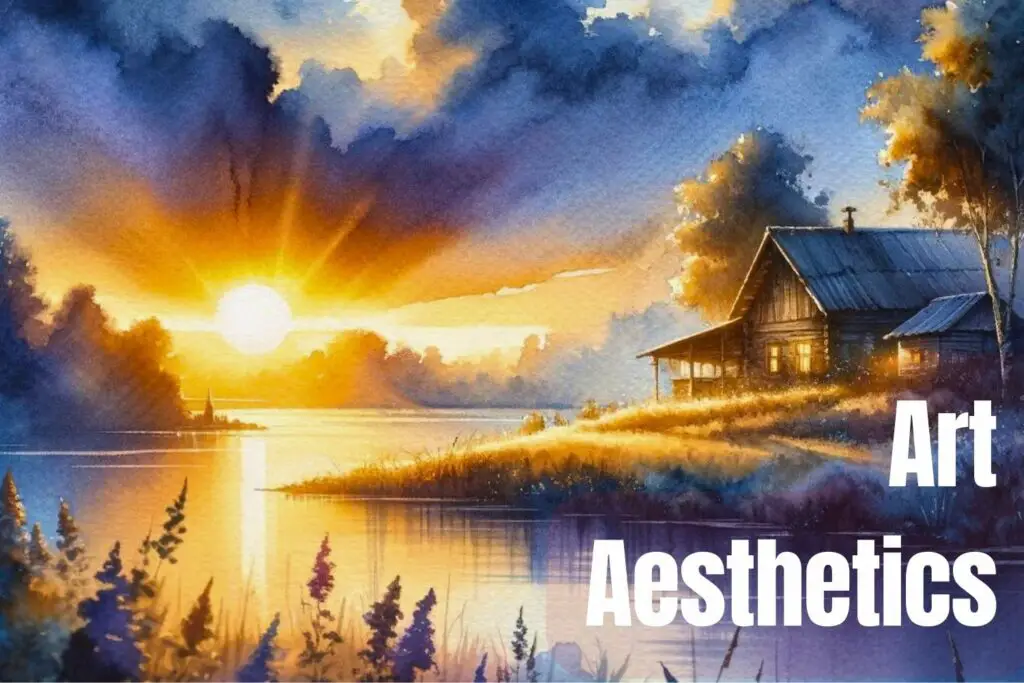Art speaks to, moves, and challenges us through its unique visual language and the composition of colors, textures, shapes, and negative space comprising an artistic aesthetic.
But what defines these aesthetics? How do artists utilize core design elements to convey meaning and evoke emotion?
This deep dive deconstructs the building blocks of aesthetics across various art forms and movements throughout history. For any art lover seeking to unlock a richer understanding of creative works, developing “literacy” in this visual vocabulary is key.
Table of Contents
What is Art Aesthetics?
Aesthetics in art refers to the sensory qualities and philosophical values underpinning a creative work’s composition, style, and visual impact. It encompasses the intentional selection, arrangement, and handling of artistic elements like color, shape, texture, and space to generate certain responses, convey meaning, and align with creative ideals.
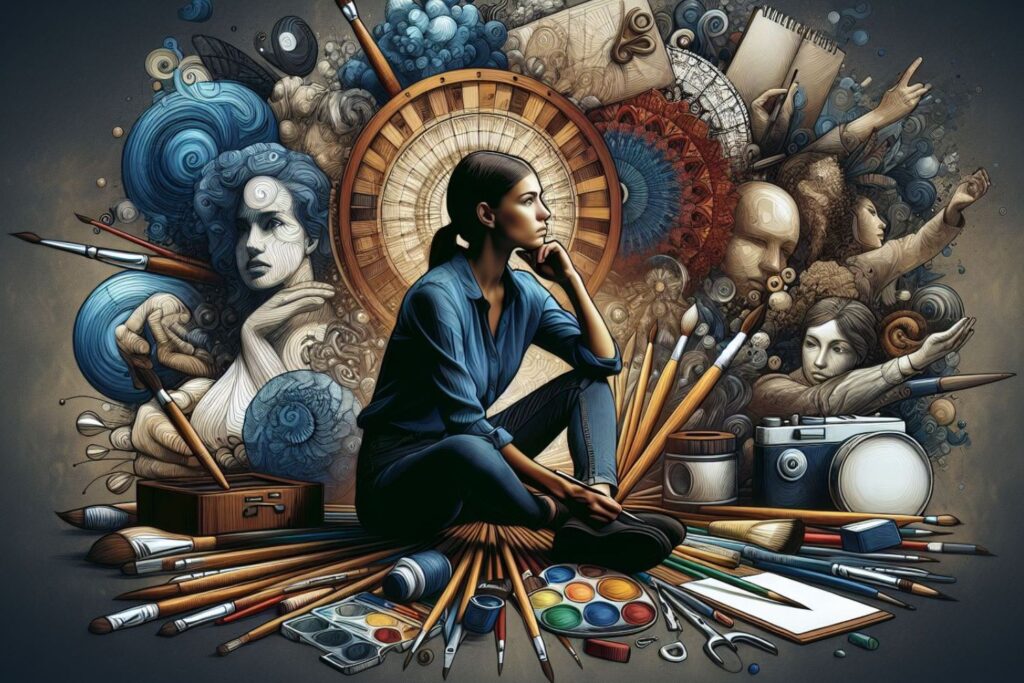
What are the Fundamental Elements of Art Aesthetics?
Artistic aesthetics are constructed from a toolkit of fundamental elements, the core ingredients an artist selects and arranges to create a specific sensory experience. Mastering control of these raw materials allows artists to craft distinct styles and inhibit unique voices. The foundational elements of visual aesthetics include:
Color: Strategically use color combinations, contrasts, tones, and palettes. Color wields tremendous psychological sway and symbolic meaning.
Texture: The look and feel of a work’s surface, which adds physical, emotional, and optical depth through tactile qualities.
Line: Outlines and edges that define spaces and connect compositional pieces. Lines convey energy and rhythm.
Shape: Flat, enclosed areas that occupy space in distinct ways to create emphasis. Shapes communicate specific ideas.
Space: Positive and negative spaces that situate subject matter to guide the viewer’s eye through the scene. Space sculpts perspective and dimensions.
Pattern: Repetitive motifs that offer visual interest, echo themes and unify elements through the consistent organization. Patterns build cohesion.
Contrast: Juxtapositions of opposing elements (light/dark, organic/geometric, smooth/textured) that make both stand out more vividly. Contrast creates dynamism.
By thoughtfully balancing these basic design ingredients, artists manifest unique aesthetics that bring their creative vision to life.
How do Color Theory and Texture Influence Artistic Expression?
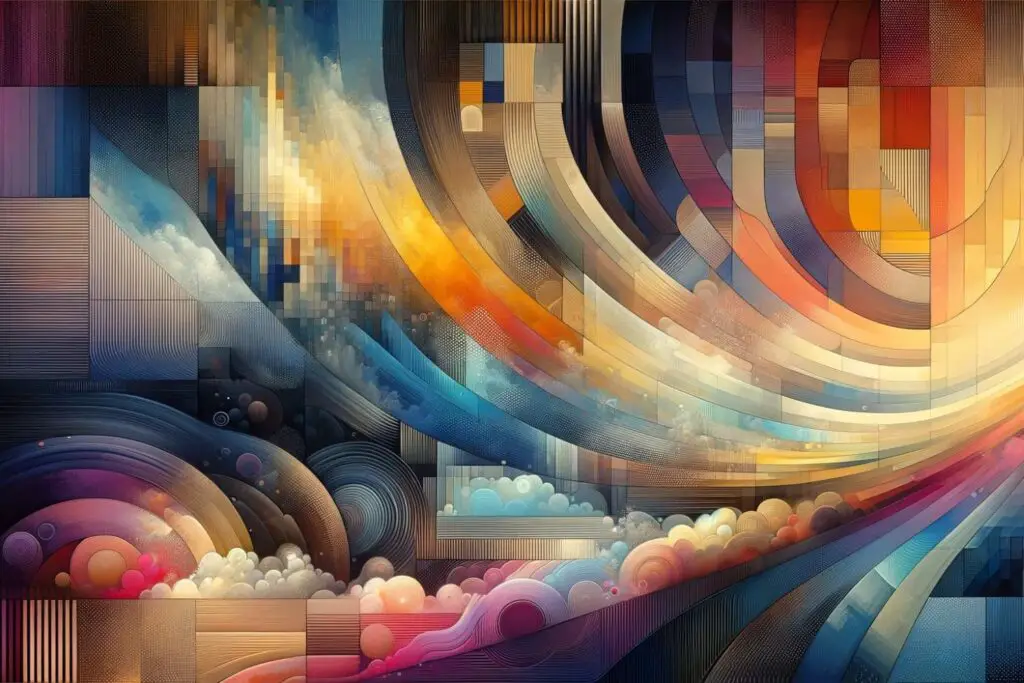
Color and texture represent two of the most emotionally impactful aesthetic elements available to artists. The strategic employment of color theory principles and textural elements allows creators across all visual media to steer viewers’ psychological and sensory responses.
Color: Hues, saturations, and value contrast elicit powerful instinctual reactions. Warm tones feel active and engaging; cool tones read as calming and reserved. Viewing red boosts excitement and appetite; blue evokes tranquility and trust. Beyond intrinsic reactions, color associations stem from learned cultural symbolism.
Color palettes establish overarching moods, focus attention on subjects through contrast, and communicate ideas via assigned meanings. For example, green and gold symbolize prosperity; black signifies grief or sophistication. Through meticulous color choices, artists influence emotions and imply narratives.
Texture: The illusion of physical texture captured two-dimensionally or actual textural qualities of three-dimensional works directly engage the brain’s tactile response. Coarse surfaces read as rugged and durable; silkiness implies luxury and delicacy. Textural contrasts within a piece create allure through this interplay of opposing qualities. Furthermore, textures impact the gaze; glossy areas draw attention, and rough patches obscure detail.
This makes texture an instrumental tool for guiding the viewer’s eye. By leveraging color and textural elements, artists direct how audiences perceive and progress through creative works on both sensory and emotional levels.
In What Ways Do Line and Shape Define Artistic Styles?
Lines and shapes represent essential tools all visual artists employ to compose structured images. Though often overlooked by casual viewers, the strategic use of lines and shapes proves integral for delineating spaces, dictating movement, and achieving intended responses. Artistic styles emphasize how these basic structural components get leveraged within compositions.
Line: All marks that define edges and divide spaces constitute lines. Variations in line style, width, sharpness, directionality, and flow elicit distinct reactions from viewers while supporting compositional goals. Thick, jagged lines seem dynamic and chaotic versus thin, wavering lines that feel fragile and dreamlike. Strong diagonals imply action, motion, and tension, while verticals and horizontals connote stability, balance, and tranquility.
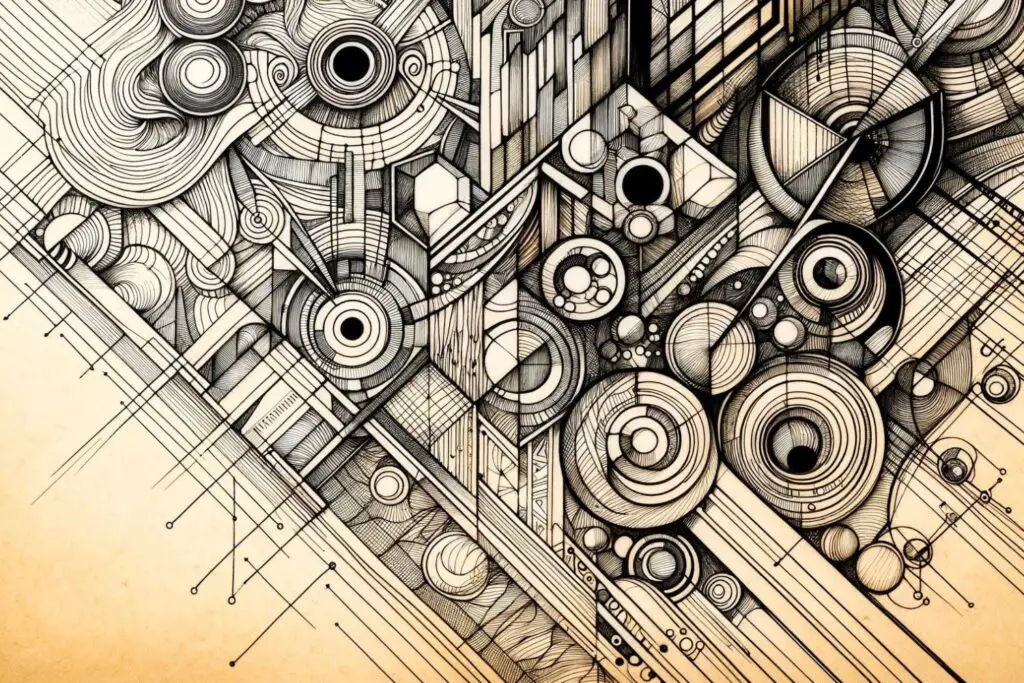
Line quality also defines representative versus abstract styles: sketchy loose contours for naturalistic images; clear, hard lines outlining figures and objects in cartoons or graphic design; no lines delineating forms in amorphous abstract paintings. Lines communicate far more than shapes alone.
Shape: Shapes describe enclosed areas defined by lines, changes in color or texture, differences in positive/negative space, or shifts in dimension. The qualities of various shapes factor profoundly into artistic styles. Angular shapes feel mechanical, aggressive, and masculine compared to curving, organic, biomorphic shapes that read as playful, feminine, and naturalistic.
Proportions and scale also matter deeply; hulking shapes loom heavy with significance, while tiny shapes feel more trivial and decorative against negative space. Abstract artists lean entirely on the lyrical interplay of non-representational shapes for visual interest. Cubists fracture familiar shapes to depict subjects multi-dimensionally. General audiences often underestimate the power of shape, yet it reigns supreme in distinguishing aesthetic approaches.
How does Space Utilization Impact the Perception of Art?
Space represents one of art’s most malleable ingredients, an invisible substance artists mold through implied perspective, scale, and subject positioning. Abstract artists, in particular, demonstrate space’s supreme potential for eliciting emotional and optical effects, while minimalists expose its hidden magnetism. Viewers intimately connect to how artists exploit negative space.
Positive & Negative Space: Compositions form through filled areas (positive space) and empty voids (negative space). When leveraged purposefully, negative space begets tangible shape and weight, and its outlines and contours manifest distinctly. Clever distribution of positive and negative space seeds impact and drama.
Compressing subjects conveys intensity and confrontation, while expansive negative space spells solemnity or longing. Overlapping shapes muddy boundaries between the two for depth and dynamism.
Perspective & Scale: Spatial depth and dimension are suggested on flat media through perspective tricks overlapping, foreshortening, and diminishing size into distance. The impression of faraway subjects against large empty voids visually communicates reverence and insignificance. Push subjects outside expected scale ranges, and they adopt monumental impact and surreality or shed importance when minimized.
Positioning & Flow: Spotlighting lone figures against swathes of negative space through asymmetrical positioning creates intrigue via contrast. Compositions guided by movement vectors that sweep through positive and negative zones breed cohesion, harmony, and fluidly interlinked elements. These spatial strategies carry emotional resonances viewers sense viscerally and subconsciously, lending great aesthetic power.
What Role Do Patterns and Contrasts Play in Visual Aesthetics?
Patterns and contrasts give compositions nuanced visual energy. They invite the eye to linger and reward sustained looking. Though often playing supporting roles, these subtler forces significantly shape aesthetic experiences.
Pattern: Repeating motifs please eyes and minds with consistency and reliability amidst the chaos. Patterns suggest infinite continuation beyond a work’s edges. Rhythmic qualities parallel musicality dots and dashes dance like playful staccatos while undulating waves flow in soothing arias.
Familiar patterns in abstract forms relapse into figurative associations through their forms of stitches, honeycombs, and topographic contours. Pattern usage unifies design elements, reinforces themes, and adds ornate appeal depending on type and placement.
Contrast: Counterposing distinct elements makes both stand out more starkly, lending punch, drama, and deeper context. Complementary color contrasts (orange and blue) create vibrating energy; value contrasts (pale skin, dark hair) naturally draw attention.
Juxtaposing round organic shapes against geometric lattice backdrops accentuates their differences. Smooth, clean textures seem especially sleek next to highly textured components. Contrast alongside uniformity breeds dynamic tension reflective of real-world diversity and finds equilibrium at composition cores.
How do Historical Art Movements Shape Modern Aesthetics?
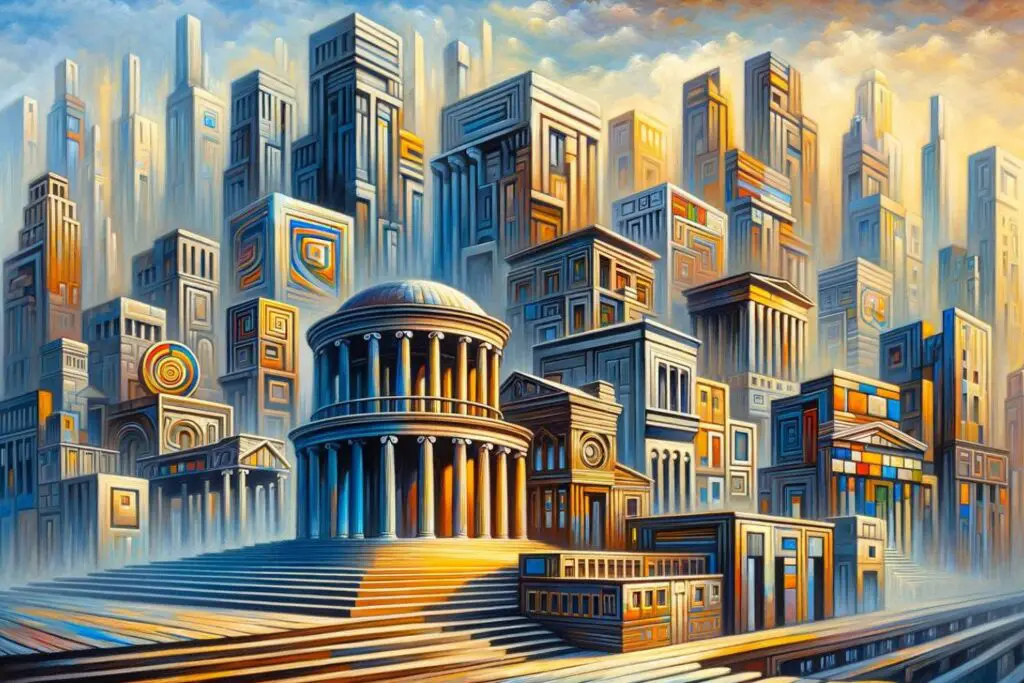
Artistic styles continually evolve yet still exhibit their ancestry. Contemporary aesthetics stand on the shoulders of past movements while upholding, overturning, or reshaping their influences. Tracing these aesthetic lineages illuminates why modern art appears and functions as it does. These seminal chapters left key trademarks that are still visible today.
What are the Hallmarks of Renaissance Art Aesthetics?
The Renaissance era refined aesthetic ideals echoed throughout Western art for centuries after. Fundamentally, the period perfected naturalistic representation through mastering perspective, anatomy, nature studies, and classical proportions. Trompe l’oeil illusionism dominated, as did rich symbolism and humanist themes. Still, a range of distinctive styles sprouted.
- Flemish attention to surface appearances, textures, details, and crisp precision
- Sienese golden-hued spiritual glow and elegant stylization
- Venetian colorism, loose visible brushwork, and dramatic chiaroscuro
- Florentine sculptural dimensionality, muscular figures, compositional geometry
These schools and their stylistic trademarks left enduring ripples. Representational painting still adheres to Renaissance spatial systems. Figurative art respects anatomy fundamentals borne of the era. The symbolist legacy continues in modern metaphorical works. Overall, the period trained Western aesthetics to admire breathtaking mimetic prowess.
How did Impressionism Alter the Aesthetic Norms of its Time?
While realism aimed to capture objective visual reality, Impressionists chased subjective perceptual experiences dependent on light, color, motion, and memory of the impressions left by a scene. Their informal brushwork, saturated palettes, candid snapshots, unusual vantage points, and oil sketch-like textures defied previous notions of finish and polish.
Monet’s serial studies chasing ephemeral effects epitomize quintessential Impressionist priorities valuing bold sensation over solid form. Impressionism’s chief contributions include:
Color: Pure, vivid color directly from the tube in thick, buttery layers. Highly saturated hues overshadowed line and detail.
Light: Capturing the flickering nuances of natural light rather than studio constancy became paramount.
Liveliness: Spontaneous, visible brush marks; compositional dynamism; and fleeting moments valued over classical stability
Feeling: Expressive handling and mood superseded precision
Shaking off restrictions on suitable styles and subjects, Impressionism opened doors to individual interpretation that modern artists continue marching through today. Its lauded masterpieces display enduring influence.
What Aesthetic Principles are Central to Abstract Art?
Defining visual art without reference to recognizable forms seems oxymoronic, yet abstraction constitutes a driving creative impulse for countless modern artists. But what unifies such radically diverse aesthetic approaches? Archetypal abstract tendencies include the following:
Non-Objectivity: Forms morph unhinged from real-world visual cues and obey independent logic as compositions explore shape, color and line purely through relationships on the picture plane.
Distillation: Homing in on subjects’ essential visual qualities (rhythm, balance, gesture) while shedding inessential details leads to minimalist elegance.
Expression: Mark-making, color, and composition get leveraged to evoke bold, visceral responses rather than represent tangible things.
Concept: Abstract visual languages communicate ideas, emotions, and symbols rather than anything observational. Interpretations stay wide open to viewer projection.
Process: The physical, creative act assumes meaning in itself. Materials leave their traces – drips, textures, layers. Medium speaks louder than imagery.
By abandoning academic requirements, abstraction diversified aesthetics exponentially, paving the way for radical individual vision.
How Has Pop Art Influenced Contemporary Artistic Styles?
Pop art of the 1960s redefined aesthetics by swiping visuals from consumer culture and contextually shifting disposable mass media into fine art. Artists like Warhol, Lichtenstein, and Ruscha reproduced comic illustrations, advertisements, product labels and Hollywood publicity photos via silkscreen, painting, and photography. The approach celebrated brash graphics, irony, collage-like mixing of commercial references, and bold, solid colors. Key aesthetic principles included the following:
- Visual punctum: Clear, eye-grabbing focal points and text/image contrasts command attention, like comic text bubbles.
- Mass media-derived content: Advertisements, celebrities, and household brand logos constitute the central subject matter.
- Flat graphics: Thick unmodulated outlines, areas of flat color, Ben-Day dot printing, no depth.
- Hard edges: No blending or delicate transitions, just crisp contours.
- Culture jamming: Art with critiques of consumerism embedded into reworked media.
Due to pop art’s lasting influences, irony, irreverence toward “high art,” and remixed cultural commentary remain strong threads in postmodern art.
How do Artists Use Aesthetics to Convey Messages?
Beyond pure formal aesthetics, artists utilize stylistic techniques strategically to communicate deeper messages and meaning. Works encoding social commentary, personal narrative, environmentalist pleas, or conceptual challenges rely on the layered use of aesthetic elements to imply, emote, symbolize, and express beyond the purely visual.
Can Art Aesthetics Influence Viewer Emotions and Perceptions?
Visual input feeds directly along neural pathways into the brain’s emotional processing centers. So, as artists intuitively understand, aesthetic qualities can predictably sway a viewer’s psychological state, steering reactions or inviting specific interpretations.
Color science confirms color-mood associations: warm hues feel passionate, and cool colors are calm. Smooth, delicate lines read as romantic versus twitchy marks that connote anxiety. Flowing compositional movement and liquid paint soothe while jagged shapes, caustic colors, and scrawled lines jar and overwhelm. Even abstracts eliciting purely personal meanings make viewers feel intuitively through their aesthetic effects, even before cognitive meaning-making occurs. All artists wield this influence; some explicitly seek or subvert it intentionally. Interpretation stays subjective, but aesthetic qualities undeniably resonate at a primal level.
How do Symbolism and Metaphor Enhance Artistic Narrative?
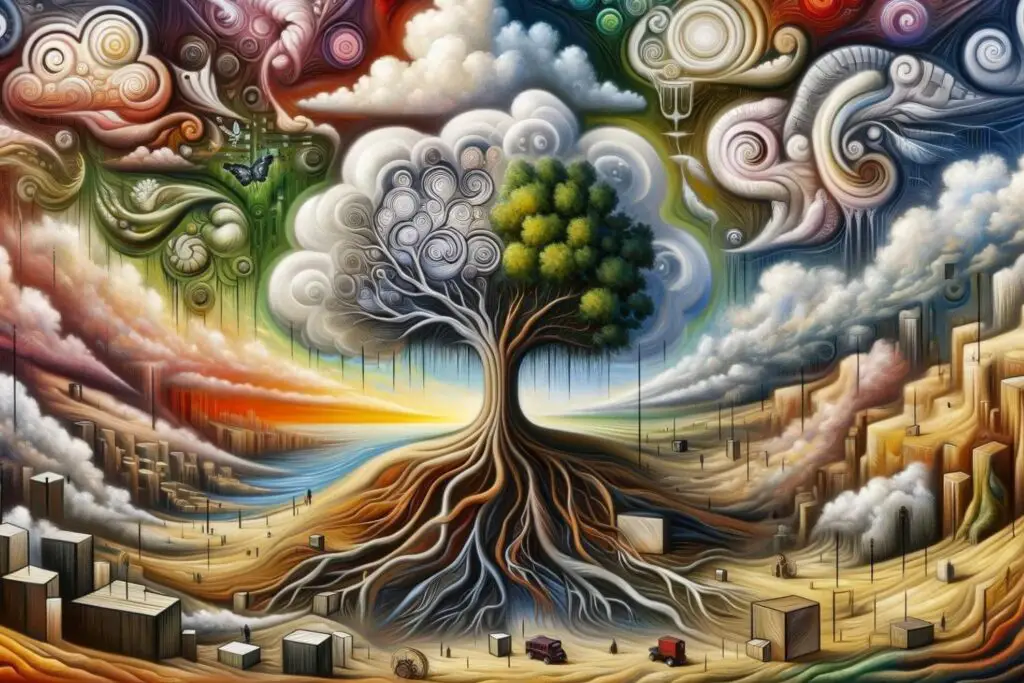
Beyond influencing basic emotions, layered symbolism and metaphor allow artists to imply broader tales and embed social commentary visually. Symbolic elements get repeatedly associated with cultural concepts until their aesthetic qualities alone conjure those connected meanings, from red roses signaling love to scales signifying justice.
More complex visual metaphors function like literary allegories using visual vocabulary instead of words. For example, a flock of birds dispersing into a clouded sky signifies a spreading idea taking flight. Photographers leverage evocative settings, subjects, and post-processing. Painters build atmospheric worlds and suggestive interplay around charged icons. Conceptual projects use aesthetic choices representative of deeper themes, such as all-white sterile rooms conveying the erasure of personality. While aesthetics trigger instinctive reactions through carefully encoded symbols and metaphors, art also communicates on philosophical levels.
What is the Role of Minimalism in Conveying Artistic Messages?
Pared-down aesthetics also carry significant messaging power. Minimalism’s practitioners reduce works to essential neutral tones, repetitive lines, emphasis on unembellished materials, and subtle qualities highlighted through omission rather than active symbolism.
In distilling compositions to bare visual fundamentals of shape, proportion, scale, and delicate materiality, minimalism confronts viewers with literal and metaphorical notions of essence and being. Sparseness comes with questions about need versus excess and humanity’s place within elemental nature. Elegant refinement points to philosophical ideals.
Beyond conceptual impact, minimalism’s austerity allows for personal, emotional, and meditative connections. Blankness projects vulnerability and reduces distraction. Bare arrangements exude power and poise. Such stripped aesthetics convey focus, clarity, and significance through sheer restraint.
How do Avant-garde Aesthetics Challenge Traditional Narratives?
The avant-garde lives at the radical fringes, always pressing against the limits of accepted norms. These bleeding edge creatives work in drastically novel ways precisely to deliver messages counter to status quo narratives, sociopolitical, cultural, environmental, or personal. Their progressive aesthetics turn tradition on its head via:
Novel mediums: Novel Mediums utilize non-art materials from the blood, soil, and plastic waste to live plants, food, found electronics, or unorthodox combinations. Shocking for shock’s sake grabs attention, while repurposed materials carry eco-conscious connotations.
Extreme sensory approaches: Through cacophonous installations, nauseating perfumes, brutal performances, and appetite-testing tastes, they sensorily assault audiences out of complacency. Discomfort forces reflection on difficult yet vital issues.
Redefining process and display contexts: Anti-commercialism values impromptu social connections and ephemeral moments over art-market commodity objects. Galleries give way to actions in public spaces or concepts as art, questioning what constitutes an artistic product.
Subverting expectations: Contemporary artists love dismantling societal assumptions and traditional media through irreverent juxtapositions, placing pornographic images in religious contexts, sculpting revered figures from garbage, and designing exhibitions to fall apart. Confronting paradoxes shake up ossified perspectives.
Through dialectic tension with orthodoxy using aesthetics as messaging vehicles, avant-gardism advances by provocation and reaction, each phase more radical than the last.
In What Ways Do Cultural Influences Reshape Art Aesthetics?
As artists reflect and challenge their societies, cultural contexts reciprocally reshape artistic aesthetics, introducing new values, technologies, materials, and ideologies ripple through creative circles. As cultures integrate today at unprecedented rates in our hyperconnected world, visual arts evolve ever more rapidly.
How do Eastern Art Aesthetics Differ from Western Traditions?
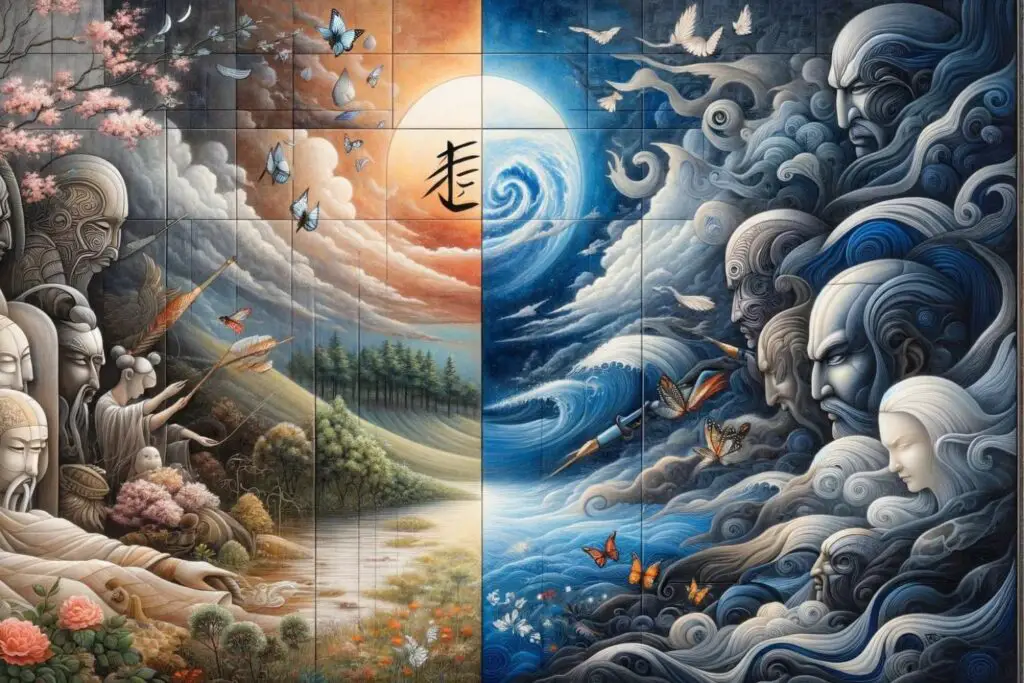
Eastern aesthetics traditionally emphasize expression through calligraphic brushwork, decentralized compositions, and empty negative space, versus Western approaches, which prioritize realistic representation initially, then individualism. Illustrated differences include:
- Flashy gold adornments and red stamping signify importance versus subdued sculptures mimicking stone.
- Miniaturist precision scenes encode multiple vantage points simultaneously, unlike single-perspective illusionism.
- Tangled, densely compressed landscapes contrast epic Romantic vistas.
- Figures and objects stay secondary to the environments they inhabit, with human-centric narratives rare. Unity with nature dominates work and Daoist philosophy.
However, Eastern modern artists increasingly merge their native aesthetics with Western styles, evidenced in Japanese manga’s global appeal and acceptance and the hybrid cultural mashups of eminent Chinese artist Ai Weiwei. As information exchange speeds up globally, artistic fusion becomes inevitable.
What Impact Does Technology Have on Contemporary Art Aesthetics?
Digital media, video tools, smartphones, and computational software expand artmaking possibilities exponentially. Tech-fueled trends include:
New mediums: Code-powered generative algorithms, 3D fabrication, machine learning image processing, and AR/VR immersion constitute a few burgeoning methods for pioneering artists. Malleable LED installations and interactive environments further transform viewer engagement.
Dematerialization: Screens host endless permutations of projected light without physical constraints. Ephemeral projection mapping reimagines surfaces and spaces dynamically. Digital work loses marketability via scarcity but gains virality, remix culture participation, and activism amplification.
Decentralized access: Online image banks, video tutorials, and global idea exchange nurture autodidactism while democratizing diversity of influences. Geo-blocking erosion makes artistic conversation genuinely global. Social media and e-commerce provide independent distribution channels outside institutional control.
By expanding artistic toolkits beyond traditional media, technology reshapes aesthetics by enabling new genres, presentation modes, and creative connections previously unimaginable. Each innovation transforms the photoreal Now.
How Have Feminist Perspectives Influenced Modern Art Aesthetics?
Women creators critically reexamine societal power structures through artistic practice-bred aesthetics centered around identity, embodiment, and meta-narratives. Feminist art trademarks include:
- Depicting visceral bodily experiences relating to sexuality, motherhood, aging and trauma counter to culturally airbrushed taboos.
- Playful low-medium explorations in textiles, ceramics, decorative arts media historically confined to “feminine crafts”.
- Pattern mixing traditionally coded male and female aesthetics and juxtaposing commercial visuals from domestic spheres.
- Performing rituals that break norms for acceptable public female behaviors and appearances.
- Spotlighting absence, gaps, and missing narratives in art history through empty plinths and inserting female subjects into canonical paintings.
Such feminist art aesthetically communicates opposition, raises provocation, makes space for marginalized voices, and challenges the status quo, all while expanding notions of appropriate artistic materials, subjects, and approaches.
In What Ways Do Environmental Concerns Manifest in Art Aesthetics?
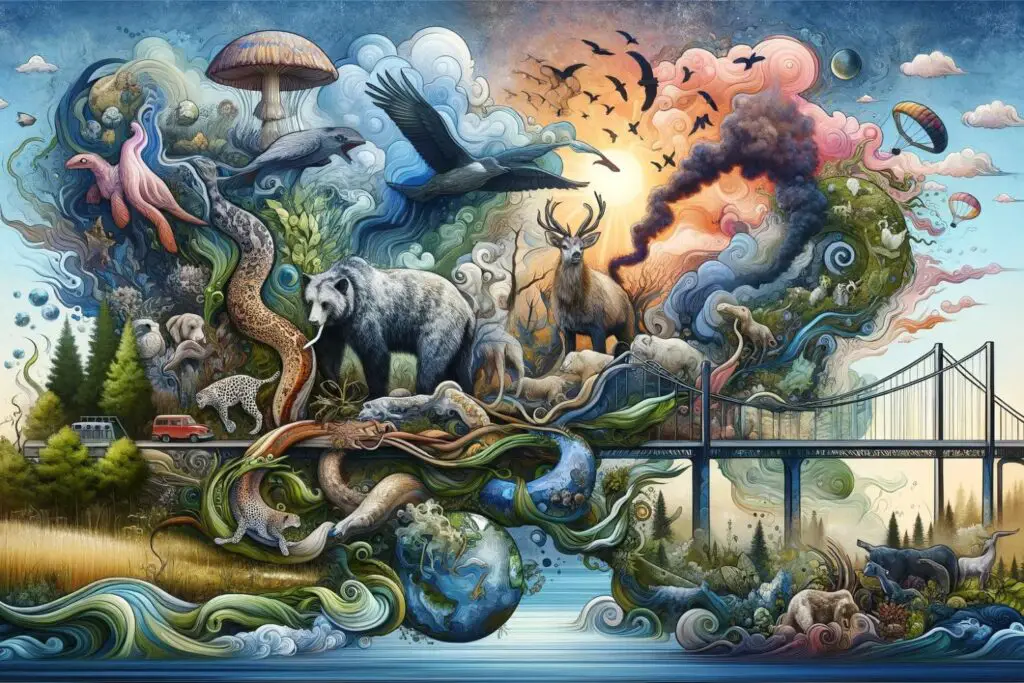
Eco-art uses ethics as an aesthetic, its imagery and visual vocabulary tuned to translate scientific data and emotional resonance around climate change into impactful creative work. Nature dwarfs humans as subjects while destroyed habitats and disappearing species become represented.
Natural processes like decay and erosion replace manual fabrication. Repurposed waste serves as a medium underscoring messages about excess and sustainability. Viewers get confronted by discomforting odors, unfamiliar forms and uncertain futures. By surfacing visually jarring yet conceptually subtle threats to beauty and balance from industry, waste, and negligence, environmental artists remind us that everything interrelates aesthetically and ecologically across beings and biomes.
How Does Understanding Art Aesthetics Enhance Our Appreciation of Visual Art?
Just as literary analysis enriches, prose and poetic study deepen the joy verse delivers, understanding the formal building blocks of aesthetics allows viewers to fully appreciate visual arts. Recognizing an artist’s thoughtful manipulation of color, negative space, shape, and other basic ingredients reveals their strategic vision.
Identifying stylistic choices tied to genres and movements adds context anchoring interpretation. Spotting encoding symbolism expands meaning. Noticing delicate materiality fosters awe for the craft. Mastering this artistic vocabulary heightens what imagery communicates and the potency of its delivery. Aesthetics lift artistic encounters from superficial beauty into a profound dialogue between creator and audience. Vision educates emotions. Knowledge seeds admiration for creativity and empathy, connecting us to shared human experience.
Conclusion:
Art transforms through pure sensory magic built from deceptively simple elements arranged by thoughtful creators. Their aesthetics talk about the innermost aspects of being. Mastering this visual language, as Bill outlined, illuminates richness hiding in plain sight. We can deepen artistic practice and lift appreciation further through engaging awareness.
Now look anew! What stunning visions await your fresh eyes? What whispers will reach newly tuned ears? An artistic adventure tailored perfectly for you starts from right here.




